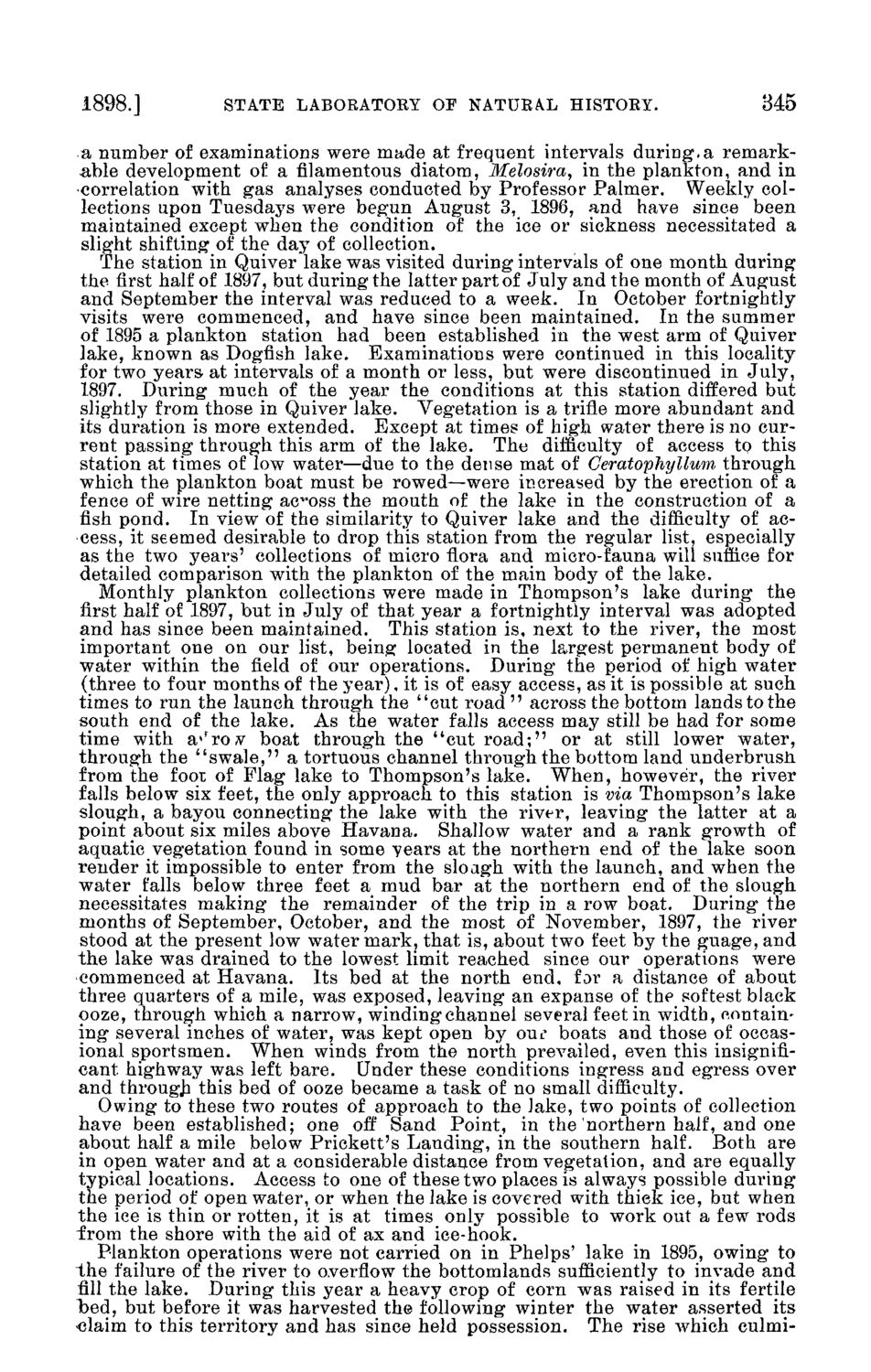| |
| |
Caption: Board of Trustees Minutes - 1898
This is a reduced-resolution page image for fast online browsing.

EXTRACTED TEXT FROM PAGE:
1898.] STATE LABORATORY OF NATURAL HISTORY. 345 a number of examinations were made at frequent intervals during.a remarkable development of a filamentous diatom, Melosira, in the plankton, and in correlation with gas analyses conducted by Professor Palmer. Weekly collections upon Tuesdays were begun August 3, 1896, and have since been maintained except when the condition of the ice or sickness necessitated a slight shifting of the day of collection. The station in Quiver lake was visited during intervals of one month during the first half of 1897, but during the latter part of July and the month of August and September the interval was reduced to a week. In October fortnightly visits were commenced, and have since been maintained. In the summer of 1895 a plankton station had been established in the west arm of Quiver lake, known as Dogfish lake. Examinations were continued in this locality for two years at intervals of a month or less, but were discontinued in July, 1897. During much of the year the conditions at this station differed but slightly from those in Quiver lake. Vegetation is a trifle more abundant and its duration is more extended. Except at times of high water there is no current passing through this arm of the lake. The difficulty of access to this station at times of low water—due to the dense mat of Ceratophyllum through which the plankton boat must be rowed—were increased by the erection of a fence of wire netting across the mouth of the lake in the construction of a fish pond. In view of the similarity to Quiver lake and the difficulty of access, it seemed desirable to drop this station from the regular list, especially as the two years' collections of micro flora and micro-fauna will suffice for detailed comparison with the plankton of the main body of the lake. Monthly plankton collections were made in Thompson's lake during the first half of 1897, but in July of that year a fortnightly interval was adopted and has since been maintained. This station is, next to the river, the most important one on our list, being located in the largest permanent body of water within the field of our operations. During the period of high water (three to four months of the year), it is of easy access, as it is possible at such times to run the launch through the "cut road " across the bottom lands to the south end of the lake. As the water falls access may still be had for some time with a* f rov boat through the "cut road;" or at still lower water, through the "swale," a tortuous channel through the bottom land underbrush from the foot of Flag lake to Thompson's lake. When, however, the river falls below six feet, the only approach to this station is via Thompson's lake slough, a bayou connecting the lake with the river, leaving the latter at a point about six miles above Havana. Shallow water and a rank growth of aquatic vegetation found in some years at the northern end of the lake soon render it impossible to enter from the sloagh with the launch, and when the water falls below three feet a mud bar at the northern end of the slough necessitates making the remainder of the trip in a row boat. During the months of September, October, and the most of November, 1897, the river stood at the present low water mark, that is, about two feet by the guage, and the lake was drained to the lowest limit reached since our operations were commenced at Havana. Its bed at the north end, for a distance of about three quarters of a mile, was exposed, leaving an expanse of the softest black ooze, through which a narrow, winding channel several feet in width, containing several inches of water, was kept open by out boats and those of occasional sportsmen. When winds from the north prevailed, even this insignificant highway was left bare. Under these conditions ingress and egress over and through this bed of ooze became a task of no small difficulty. Owing to these two routes of approach to the Jake, two points of collection have been established; one off Sand Point, in the northern half, and one about half a mile below Prickett's Landing, in the southern half. Both are in open water and at a considerable distance from vegetation, and are equally typical locations. Access to one of these two places is always possible during the period of open water, or when the lake is covered with thiek ice, but when the ice is thin or rotten, it is at times only possible to work out a few rods from the shore with the aid of ax and ice-hook. Plankton operations were not carried on in Phelps' lake in 1895, owing to the failure of the river to overflow the bottomlands sufficiently to invade and fill the lake. During this year a heavy crop of corn was raised in its fertile l)ed, but before it was harvested the following winter the water asserted its •claim to this territory and has since held possession. The rise which culmi-
| |